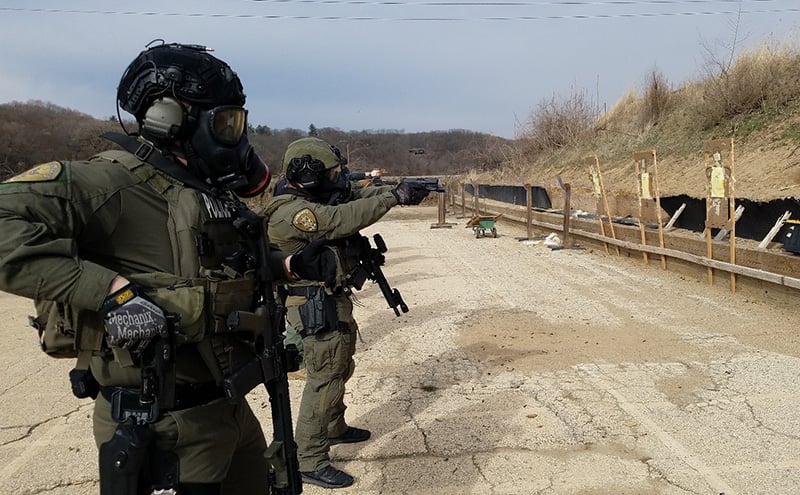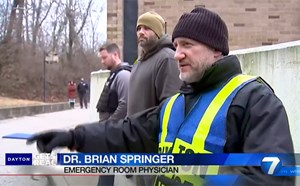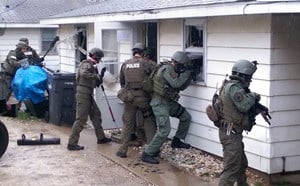
The Armed Tactical Medical Professional - Weapons Selection for the Tactical Medical Provider
There is growing acceptance of arming tactical medical professionals (TMP) and other EMS providers while on duty. While significant controversy still exists, there are definite advantages to having an armed TMP who is well-trained on their weapon platform. These include their ability to provide security for themselves and for casualties under their care; enhanced provider safety while inside a hostile perimeter; and reducing the number of officers assigned to force protection for medical personnel. For this article, we are going to focus on handguns in their role of defensive weapons. While long guns such as rifles and shotguns may be appropriate for TMPs in some situations, the pistol is the ideal weapon in most circumstances: it is compact, lightweight, easy to carry, allows use of both hands for medical care when holstered, and can quickly be accessed and brought into action if needed.
Before any decisions are made on weapon selection, the TMP must be intimately familiar with the legalities of carry that will affect them on operations. For TMPs who are sworn law enforcement, this means knowing the policies of your agency and state. Being sworn is not an open invitation to carry at all times, even on operations, and you need to ensure that your sponsoring agency and any other agencies with whom you are working have your back. Will qualified immunity apply? Who is providing coverage for non-civil suits that may arise from your actions? If you start asking these questions after you have been involved in a shooting, you are in some serious hot water. Laws that allow civilian TMPs to be armed while working with law enforcement are becoming more frequent and are meant to provide protection from civil suits, but they have not really been tested much in the courts. Be sure you and your agency understand the laws and that they are being followed to the letter. Springer’s Tactical Medicine Rule #1: you do not want case law to be named after you.
Much like in medicine, to gain a broad understanding of the defensive use of the pistol and other firearms, you need to immerse yourself in the literature. And much like the medical literature, the majority of what is out there to read about firearms (particularly online) is junk. Most of what you will find is either opinion, advertising, or a combination of both. I strongly recommend you find and study everything written by Massad Ayoob and David Spaulding. Ayoob is arguably the expert in the legalities of defensive shootings, and also possesses a wealth of real-world experience and advice about weapons, sights, holsters, and how to run a gun. Spaulding’s grasp of pistolcraft, tactics and training is unmatched. There are a host of other fantastic trainers out there who publish books and blogs worth your time. To get a great overview, go to Active Response Training, hosted by Greg Ellifritz, and check out his Weekend Knowledge Dump (Greg’s own posts are highly informative, too.)
When it comes to selecting a pistol, your primary considerations will be purpose, appropriateness for the end user, and cost. I strongly suggest that, if practical, the TMP run the same or at least a similar platform as the operators on their team. This may not be practical with multi-agency teams where you see multiple manufacturers, models and calibers. The advantages to carrying the same platform as your team members include:
- Familiarity with the weapon should a situation arise where you need to handle an operator’s weapon, whether to fire it or render it safe.
- The above applies if an operator needs to access your weapon.
- Having the same caliber and compatible magazines allows for ammunition to shared in the event of an extended operation.
- Similar maintenance procedures and supplies allows the TMP to keep the weapon well maintained and duty-ready
- In the event of a shooting, the fact that you are carrying the same sidearm as your team members eliminates the ability of a plaintiff’s attorney to single out your weapon and try to make it look like you were itching for a fight or wanting to shoot someone.
Most TMP’s will best be served by a mid- to full-size duty weapon in one of the popular calibers used by law enforcement: 9mm Luger, .40 S&W caliber, or .45 caliber. If the agency you support uses a more exotic caliber such as .357 Sig or .45 GAP, fine, but otherwise avoid due to both availability and cost. Thanks to advances in modern bullet design and performance, many agencies are using or switching to 9mm. Recoil is generally not an issue in a full-sized pistol, but .40 can be pretty snappy and any caliber will generate significant recall in a small-framed weapon. Polymer-framed, striker-fired pistols are the weapons most often carried by LE, and you really cannot go wrong with the service pistols manufactured by Glock, Smith & Wesson, Sig Sauer, and several other companies. External hammer duty weapons in double action/single action or double action only are also popular among LE and excellent weapons. Single action only pistols such as the plethora of 1911 variants are excellent weapons, but require a higher degree of skill to safely handle and to properly maintain. If you carry a pistol with a manual safety, it provides an extra layer of security in prevention of an unintended discharge and reduces the odds that gun will be effectively used against you if taken by an assailant. Manual safeties also create an extra layer of complexity and must be mastered so they can be properly manipulated under duress. Depending on your own size and strength, different models by the same manufacturer (even in the same caliber) will fit your hands differently and be easier or harder to shoot. Ask trusted members of your team for the opportunity to fire their handguns. Go to a range where handgun rentals are available and try out multiple models. Adjustable grip sizes such as those available on the newer generation Glock pistols are also a plus. Expect to spend at least 400-500 dollars on the weapon. Many dealers will offer discounted pricing to LE and EMS personnel.
Along with the pistol, you will need several critical accessories. Along with the extra magazine or magazines you plan to carry in the field, you should own extra for training. Investing in at least a half dozen beyond those supplied by the manufacturer up front will provide a good start. If the pistol does not come equipped with quality high-visibility sights, get them installed right away. For duty purposes, a quality weapon light such as those manufactured by Streamlight or Surefire provides enhanced target identification in low-light conditions. Consider using a red dot optic. Many pistols now come from the manufacturer ready for a red dot to be mounted, and there are excellent gunsmiths who can mill slides for a custom fit. Do not, absolutely, never ever, put controversial graphics or writing on your pistol. A Punisher skull may look cool on the slide cover plate of your handgun, but it will not look cool when projected on a wall in front of a grand jury trying to decide if your actions in a shooting were justified.
A quality holster is a must. Do not spend hundreds of dollars on a handgun and then carry it in a flimsy nylon piece-of-junk holster. Duty holsters made by Safariland, Blackhawk, and others will keep your pistol secure while still allowing a rapid draw when needed. If you decide to mount a light on your weapon, be sure your holster is compatible. Recently there has been backlash against holsters whose retention mechanism is unlocked by the index (i.e. trigger) finger. Best to avoid these and purchase a holster where the thumb actuates release. Again, look and see what your team is using, and allow them to help guide your selection.
If you have not already done so, get quality training. There are so many excellent instructors and resources out there, I could not possibly name them all. Do your research and check up on instructors credentials and student reviews. Before you start signing up for high-speed-low-drag-ninja-classes, you need to master the fundamentals. Sight alignment, sight picture, trigger press, presentation from holster and ready positions, reloads, multiple targets, immediate action, tactical movement, shooting on the move, low light, weapon retention, etc., etc., etc. Getting some qualifications and drills in with your team is a great start (and great way to get free ammo) but the burden is on you to develop a basic skill set that will ensure the safe and effective deployment of your weapon in a life and death situation. You also need to have at least basic gun handling and safety skills in place BEFORE you hit the range with your team. If you create a hazardous situation (unintended discharge, accidentally pointing the muzzle end of your weapon at another officer, etc.) you will be asked to step off the line. You will also reduce the team’s confidence in your ability to work safely in a tactical environment. They do not expect you to be a gunfighter, but absolutely expect you to be able to safely handle a firearm.
You also will need to invest in practice ammunition and get out to the range on a regular basis. Running a gun is a perishable skill, and you should always show up at your practice range with a pre-arranged plan of skills you intend to polish and drills you will run to do so. Many ranges have competitive shooting leagues. While the rules, regulations, and scenarios may differ from what you are likely to encounter operationally, some friendly competition is a great way to turn up the stress levels, challenge your abilities, and further develop your skills.
Remember: always keep learning and maintain an emphasis on safety. Know the rules for use of force, how they apply to the TMP, and how to use sound tactics to keep yourself and others safe. The best gunfight is the one that you avoid getting into.
Below are just a few suggested reads and resources for the novice and experienced shooter. Reach out to your LE colleagues for more.
- Massad Ayoob, The Gun Digest Book of Combat Handgunnery, 7th Edition (pretty much everything you need to know about the use of the handgun as a defensive weapon)
- Massad Ayoob, In the Gravest Extreme: The Role of the Firearm in Personal Protection (although focused on civilian defensive shooting, the author’s discussion of the legal aftermath of a shooting is a must-read)
- Raffaele M. Di Giorgio, Legal Considerations for Tactical Medical Responders, 2nd Edition (not focused on firearm carry specifically, but an in-depth discussion of the legalities of tactical medicine)
- Dave Spaulding, Handgun Combatives, 2nd Edition (a great resources on how to run a gun defensively and maintain your skill set.)
- http://www.activeresponsetraining.net/ (excellent coverage of all-things-self-defense-related, and a great way to find other online resources worth your time)



